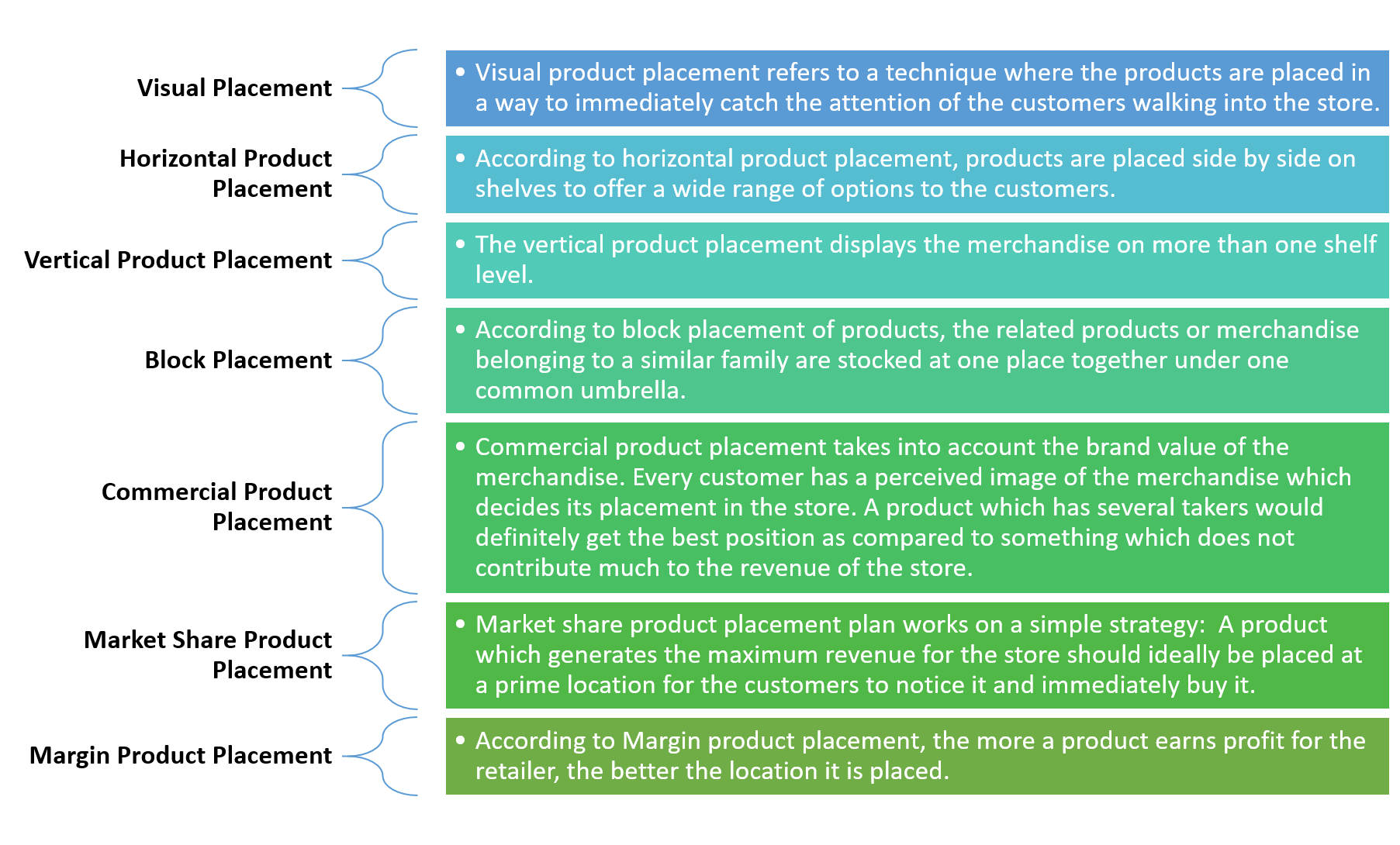The following guidelines are helpful in terms of the placement of different products.
- The heavier products are placed at the bottom and the smaller units are placed on top.
- The gradation in the shelf is too big and right to left as we face it, the prime reason being our tendency to look from left to right every time, and not the other way around, hence even the higher priced products are placed at the right-hand corner.
- The eye level shelves, which are between shoulder heights to hip level get maximum reach, here the main products, are displayed and focused upon.
- All products placed on pallets should be at chest level.
- Merchandise displayed below the knee level is lost to a customer. This space should be utilised to store excess merchandise required for replenishing.
But, product placement can also be tactical, based on the product type, use and shellability.

Product handling is a very crucial aspect in retail. Stacking same items one above the other must be carefully executed to avoid unnecessary damages/scratches to the items. Movement of items is to be limited and performed only if it is to be replenished.
Click here to view a video about product placement.
Prioritizing Seasonal Merchandize
The display of the products at the retail store must entice the customers. The merchandiser in coordination with the store manager must ensure that the products are according to the season as well as latest trends.
The merchandiser must:
- Source something which is unique and not available at any other retail store.
- Never compromise on quality of the merchandise. Compromising on quality costs later.
- Source merchandise as per the season and climate.
By mid of August and early September, the winter merchandise is generally on a close out and stores begin stocking merchandise for the summer season. Warm clothing, full sleeves apparels, jackets, pullovers start replacing cut sleeves, capris, ankle length dresses, shorts and so on. Colourful clothes dominate the shelves as compared to the subtle colours in summers. The type of product sourced also depends on the climatic conditions of the place.
Placing Stock On The Floor
In most of the general stores and supermarkets, the placement of stocks on the floor is not up to the mark. One will notice that stocks are just placed wherever space is available, and a signage is placed besides it. You will also notice signage which says, “TOUCH IT, FEEL IT, BUT CONSIDER IT SOLD IF BROKEN”. Such signage is very prominent near crockery and gift article section.
Just to make maximum utilisation of space does not mean one should get into such an activity inside the store. It is very essential to plan your space properly to display merchandise. Proper stacking of merchandise on the store floor plays an important role in reducing stock damages. Merchandise should be stacked on the floor in such a manner that goods are not dumped on each other thereby damaging them.
Placing Fragile Stock
- Because of not placing merchandise properly on shelves the chances of damage to goods is high.
- Items which are fragile in nature e.g. crockery, toys, electronic items, etc. should always be placed or stacked one by one on a rack.
- They should never be all dumped together or placed haphazardly.
- For fragile goods, the shelf space should be enough for just one row of items.
- The staffs should also take care to place every product in such a manner that there is adequate space between items to enable one to easily pick a piece from the shelf.
Merchandizing Food

All the products which have come recently are placed behind on the shelves and the products arrived earlier are placed in front on the shelves. This way the older products are sold ahead of the recent ones.
First in first out method (FIFO) needs to be strictly followed for Fast-moving consumer goods (FMCG) goods, as they are perishable goods. Retailers cannot afford to keep these goods on the shelf for a longer period as they will increase the retailers’ shrinkage.
Loose food grains, and other types of staple products mostly come in sacks. Care should be taken when they are stacked on top of each other. The stack of sacks should not be very tall, but convenient enough for the staff to manage it.
Soft drinks, tetra pack products, mineral water bottles need to be stacked along with the carton one above the other.
Only the topmost carton need to be opened and the product displayed for the customers
Merchandizing Fast Moving Consumer Goods
When placing merchandise on shelves and other fixtures, you need to note the first in first out method (FIFO). It helps the retailer to clear the stocks that have come in first on the floor from the shelves first.
In this method, the products are placed according tor:
- Brand
- Type
- Batch No
- Expiry date
- Weight
- Size
- Material requirements planning (MRP)
Placement of Apparels
The placement of stocks in case of apparels should be:
- Brand wise
- Product wise
- Style wise
- Size wise
- Colour wise
- Price wise as per the demand of the store and the nature of the merchandise
- The direction of placement should be top to bottom and left to right
Special Items
Displays of seasonal or specially priced merchandise can be put temporarily in key locations. Most commonly used are end-caps - displays set up at aisles ends. Merchandise placed at the end-cap can also be found in its regular stock location, but if customers fail to see it in the aisle, they are not likely to miss it on the end-cap. Non-sale items are also placed on end-caps to tempt customers and to make them think they are getting a special price on the product.
Click here to download a checklist for merchandising placement.